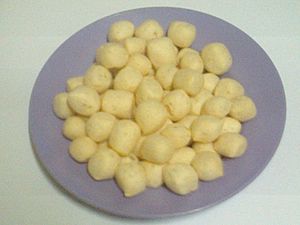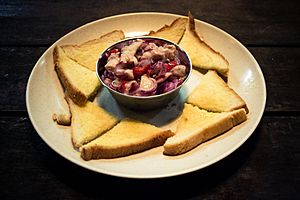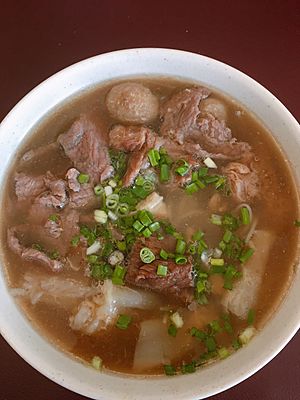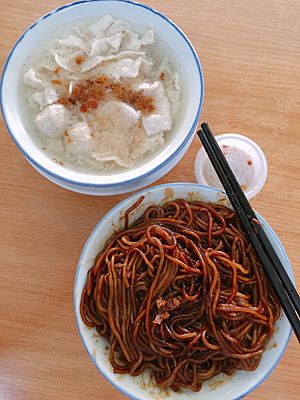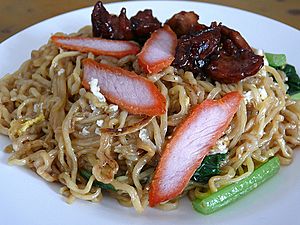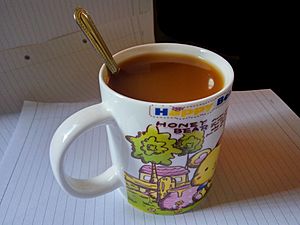Sabahan cuisine facts for kids
Sabahan cuisine is the special food from the state of Sabah in Malaysia. Just like other Malaysian foods, Sabahan meals often feature rice. But what makes Sabah's food unique is the huge variety of other ingredients and cooking styles. This is because Sabah has many different landscapes and local cultures, which are quite different from the food found in Peninsular Malaysia. Sabah, along with its neighbor Sarawak, is famous for having many different ethnic groups, and each group brings its own flavors to the table!
Delicious Dishes
Here are some of the unique foods and drinks you can find in Sabah:
- Amplang are crunchy crackers. They are made from Spanish mackerel fish, tapioca starch (a type of flour from a root vegetable), and other seasonings. Then, they are deep-fried until crispy.
- Beaufort mee is a special noodle dish from Beaufort town. The handmade noodles are first smoked, which gives them a unique flavor. Then, they are stir-fried in a wok with meat (like slices of roasted pork) or seafood and lots of green vegetables called choy sum. Finally, a thick, yummy gravy is poured over everything.
- Bosou, also known as noonsom or tonsom, is a traditional Kadazan-Dusun dish. It's a tangy (slightly sour) fermented meat. Fermentation is a process where good bacteria help preserve and change the flavor of food. A key ingredient is smoked and crushed buah keluak nuts, also called pangi, which act as a natural preservative. Fresh meat or fish is mixed with rice, salt, and these nuts, then sealed in a jar to ferment. Sometimes, bananas and pineapples are added too!
- Century egg dumpling is a special dumpling from Sandakan town. It has a piece of century egg inside, which is a special preserved egg. It's often served with noodles.
- Fried pork is another specialty from Sandakan. Specially marinated pork is fried until golden, then sliced. It's usually served with soup and wide vermicelli noodles, or sometimes with dried noodles.
- Hinava is a traditional Kadazan-Dusun dish made from raw fish. The fish is "cooked" by marinating it in lime juice, which makes it firm and flavorful. Usually, firm white fish like mackerel is used. It's mixed with lime juice, sliced shallots, chopped chili, ginger, and grated dried bambangan fruit seeds. Sometimes, bitter gourd is added. You can also make hinava with prawns.
- Kelupis and Ketupat are types of food wrapped in leaves, often made from rice.
- Linongot is a leaf parcel, usually made with irik or tarap leaves. It's filled with cooked rice and root vegetables like sweet potatoes and yam.
- Nasi kombos is a rice dish from the Lotud community. Glutinous rice (sticky rice) is cooked with young coconut water, then mixed with the soft, grated flesh of a young coconut. It's traditionally served in a hollowed-out coconut shell.
- Nonsoom bambangan is a pickle made from half-ripe bambangan fruit. It's mixed with grated dried bambangan seed and salt, then sealed in a jar to ferment for weeks.
- Ngiu chap is a Chinese-influenced dish. It's a beef or buffalo broth served with noodles. The soup usually contains slices of poached beef or buffalo meat, meatballs, stewed brisket, tendons, liver, and other parts of the animal. It's a very popular Sabahan dish with many different versions, from lighter styles to richer ones.
- Nuba laya or Nuba tinga is plain rice wrapped in a banana or nyrik leaf. This dish is popular among the Lun Bawang/Lundayeh people. It's easy for farmers and travelers to carry on long journeys. The rice is very soft, making it easy for older people to eat. Nuba means rice, laya means soft, and tinga means wrapped.
- Piaren Ah Manuk is a chicken curry from the Iranun community. It's made by cooking a spice paste (rempah) and grated coconut, then simmering it in coconut milk. You can also find versions with fish (Piaren Ah Sada) or unripe jackfruit (Piaren Ah Badak).
- Pinasakan or Pinarasakan is a home-style Kadazan-Dusun dish. It's fish simmered with takob-akob (dried skin of a fruit that makes it sour) or slices of unripe bambangan fruit, along with fresh turmeric leaves and roots.
- Sagol or sinagol is a Bajau specialty. Fish is first blanched (briefly cooked in hot water) and minced, then stir-fried with turmeric, garlic, ginger, onions, and crushed lemongrass. Traditionally, the oil used comes from the liver of the same fish. This dish can be made with shark, stingray, or even puffer fish.
- Sang nyuk mian is a noodle dish with pork broth, originally from Tawau. It's very popular with non-Muslim communities in Sabah. The name means "raw meat noodles" because tender, marinated pork slices are poached (gently cooked) right when you order. The noodles are usually thick yellow noodles, served either mixed with dark soy sauce and lard, or in the soup with the pork, vegetables, meatballs, and other pork parts.
- Sinalau is smoked meat, usually wild boar, prepared in the Kadazan-Dusun style. It's barbecued over charcoal and eaten with rice and dipping sauces. You can find sinalau bakas (wild boar) in rural areas and towns. Halal versions (allowed in Islam) use other game meats like deer instead of wild boar.
- Sinamu baka is a traditional Lun Bawang/Lundayeh fermented food. It's similar to Bosou but specifically made with wild bear meat.
- Tompek is a Bajau food made from grated tapioca (also known as cassava). It's eaten as a starchy food instead of rice. The grated tapioca is squeezed to remove water, crumbled, then fried or toasted until golden. Grated tapioca can also be steamed in cylindrical shapes to make a chewy cake called putu, another traditional Bajau food.
- Tuaran mee is a special noodle dish from Tuaran town. These fresh, handmade noodles are stir-fried in a wok. It's also well-known in Kota Kinabalu and Tamparuli town, where it's called Tamparuli mee. The noodles are first toasted in oil to prevent sticking, then blanched (briefly cooked in hot water) to soften them. Finally, they are stir-fried with eggs, vegetables, and meat or seafood until dry.
- Tuhau is a type of wild ginger plant. The stems are often chopped up and served fresh with lime juice, or mixed with local chives and chili peppers, then preserved with salt and vinegar. A newer recipe, serunding tuhau, involves slicing the stems into thin shreds and stir-frying them until golden and crispy. It has a very strong, unique smell that some people love and others find unusual!
- Ubi Daun Kayu refers to tapioca leaves. This is a traditional food for the Murut and Lun Bawang/Lundayeh people.
- UFO tart (also known as cow-dung tart) is a famous pastry in Sandakan town. It's made of custard and cream shaped like a cow dung on top of a thin, fluffy, round cake slice.
Drinks
Non-alcoholic Drinks
- Sabah Tea is the main local tea brand from Sabah.
- Tenom coffee is Sabah's main local coffee brand. It's made using traditional methods with firewood and rotating drums, a process that has been used for almost 50 years without adding any artificial ingredients or colors.
Alcoholic Drinks
- Bahar or baa is a type of palm wine made by the Kadazan-Dusun people. It's made from the sap collected from a young coconut tree's flower bud. A special tree bark called rosok, found only in the Tuaran district, is dipped into the coconut sap during fermentation. This gives the drink a reddish color.
- Lihing is a rice wine made only from glutinous rice and a natural yeast called sasad. It tastes bittersweet. Lihing is a specialty of the Kadazan Penampang community, where many people still make it at home. Lihing can be used to make chicken soup (Sup Manuk Lihing), as a marinade for meat, or even as an ingredient in meat pastries and stir-fried dishes. You can buy commercially made lihing in souvenir shops, which is more expensive but has a consistent quality. Lihing and similar rice wines can also be distilled (a process to make stronger alcohol) to produce a hard liquor called montoku or talak.
- Tinonggilan is a slightly sparkling alcoholic drink made from maize (corn). It's a Rungus specialty and is usually served during festivals or as a refreshing drink for guests during a traditional dance called Mongigol Sumundai.

All content from Kiddle encyclopedia articles (including the article images and facts) can be freely used under Attribution-ShareAlike license, unless stated otherwise. Cite this article:
Sabahan cuisine Facts for Kids. Kiddle Encyclopedia.

